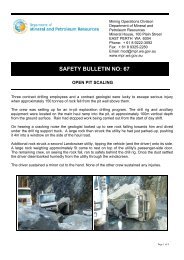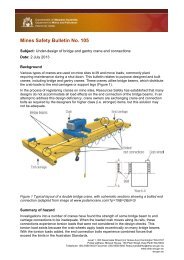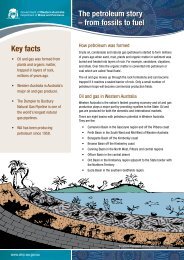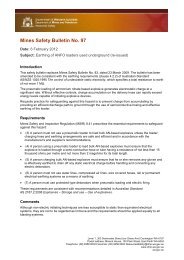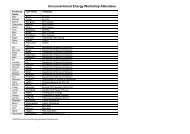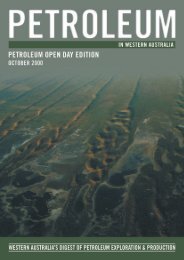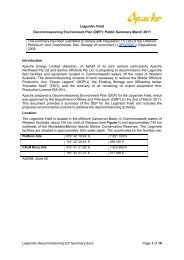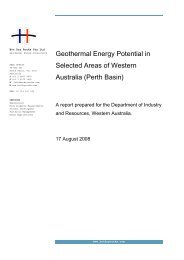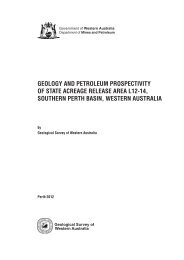Phase III - Department of Mines and Petroleum
Phase III - Department of Mines and Petroleum
Phase III - Department of Mines and Petroleum
You also want an ePaper? Increase the reach of your titles
YUMPU automatically turns print PDFs into web optimized ePapers that Google loves.
There is a tendency to treat geochemical <strong>and</strong> geomechanical effects as independent <strong>of</strong> each other. One<br />
concern is that the number <strong>of</strong> geochemical reactions predicted by the modelling (although predicted<br />
porosity changes are small), may geomechanically weaken the seal. If feasible, “chunks” <strong>of</strong> the seal should<br />
undergo geochemical autoclave experiments <strong>and</strong> the reaction products undergo geomechanical testing.<br />
Integrity <strong>of</strong> Existing Wells<br />
Long-term well integrity issues for the geological disposal <strong>of</strong> CO 2 are currently not well understood <strong>and</strong> are<br />
an area <strong>of</strong> active research by many groups internationally. The GJV have recognized this situation in their<br />
documents ‘Technical Evaluation <strong>and</strong> Basis for Development Concept’ <strong>and</strong> ‘Uncertainty Management<br />
Plan’, <strong>and</strong> have incorporated operational <strong>and</strong> ab<strong>and</strong>onment practices to accommodate these uncertainties.<br />
The strategy for ab<strong>and</strong>onment <strong>of</strong> the existing 27 (pre-Data Well) wells penetrating the Dupuy Formation<br />
will be reactive. If the monitoring <strong>and</strong> surveillance plan <strong>and</strong> plume migration forecasts indicate that CO 2<br />
leakage from an existing well is imminent, plans will be developed which may include plug <strong>and</strong><br />
ab<strong>and</strong>onment operations. These operations may incorporate multiple levels <strong>of</strong> redundancy for long-term<br />
sealing. The generic cased-hole <strong>and</strong> open-hole remediation operations developed by the GJV are consistent<br />
with <strong>and</strong> generally surpass current international well ab<strong>and</strong>onment approaches. For the cased-hole plug<br />
<strong>and</strong> ab<strong>and</strong>on generic programme, the GJV has gone beyond operational concerns <strong>and</strong> recognised the<br />
importance <strong>of</strong> eliminating potential areas <strong>of</strong> leakage due to long term corrosion <strong>of</strong> the casing.<br />
The GJV have, however, identified three existing wells (the Data Well, P18J <strong>and</strong> U22J) that may<br />
potentially have the greatest exposure to the CO 2 plume <strong>and</strong>, it is recommended that a more comprehensive<br />
ab<strong>and</strong>onment plan for these three 'at risk' wells should be adopted. The acquisition <strong>of</strong> downhole materials<br />
(casing steel <strong>and</strong> cement), during ab<strong>and</strong>onement operations <strong>of</strong> these wells, <strong>and</strong> the assessment <strong>of</strong> their<br />
ageing characteristics could assist the GJV with managing the ab<strong>and</strong>onment requirements <strong>of</strong> the remaining<br />
well assets on Barrow Isl<strong>and</strong>. This might also assist in formulating the most appropriate ab<strong>and</strong>onment<br />
options for the injection <strong>and</strong> observation wells.<br />
Injectivity<br />
Injectivity estimates depend on the reservoir model <strong>and</strong> the data that was used to develop it. The GJV have<br />
undertaken a number <strong>of</strong> studies addressing injectivity <strong>and</strong> further issues are expected to be addressed as<br />
part <strong>of</strong> their <strong>Phase</strong> IV technical work programme.<br />
Injectivity Data Sources<br />
Injectivity performance predictions can be made using data from routine core analysis, mini-permeameter<br />
measurements, core-flood experiments, well testing <strong>and</strong> numerical reservoir simulations. The GJV<br />
analysed 1593 core samples <strong>and</strong> collected 4518 mini-permeameter readings over a 503 m interval from the<br />
Data Well. The GJV workflow makes significant use <strong>of</strong> numerical simulation, as is accepted practice in<br />
petroleum field development, <strong>and</strong> this is considered the most appropriate tool for analyzing injectivity in<br />
heterogeneous reservoirs.<br />
Well Tests<br />
An injection test was conducted in the Data Well using brine as the injection fluid as opposed to CO 2 . This<br />
allowed the horizontal permeability <strong>of</strong> the formation to be determined with greater certainty than if CO 2<br />
had been used as an injection fluid. The GJV assessed the impact <strong>of</strong> multiphase flow on injectivity via a<br />
combination <strong>of</strong> an extensive review <strong>of</strong> published data <strong>and</strong> numerical reservoir simulation models.<br />
The GJV faced some operational difficulties during their well testing programme (e.g., cement debris <strong>and</strong><br />
formation material plugging pore throats). We believe that the GJV responded to these problems with<br />
appropriate modifications to their well testing programme. The results <strong>of</strong> the three drill stem tests (DSTs)<br />
xxix



